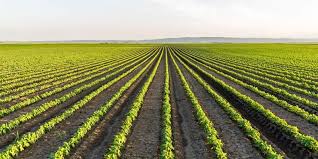Agriculture is the foundation of human civilization. It involves the cultivation of plants and the raising of animals for food, fiber, and other products used to sustain and enhance human life. As the world’s population continues to grow, the importance of agriculture becomes increasingly significant. This article will define agriculture, provide a historical overview of agricultural practices, and explore the various types of agriculture.
The Definition of Agriculture
Agriculture can be defined as the science and art of cultivating soil, growing crops, and raising livestock for human use. It encompasses a wide range of activities, including planting, harvesting, breeding, and managing animals and crops. Here are some key components of agriculture:
1. Crop Production: This involves growing various types of plants for food, such as fruits, vegetables, grains, and legumes.
2. Animal Husbandry: This focuses on raising livestock for meat, milk, eggs, and other products. It includes the care, breeding, and management of animals.
3. Horticulture: This is a specialized branch of agriculture that deals with the cultivation of garden plants, fruits, vegetables, and ornamental plants.
4. Aquaculture: This is the farming of aquatic organisms, such as fish, shellfish, and aquatic plants. It plays a vital role in providing food and sustaining fish populations.
5. Agroforestry: This practice combines agriculture and forestry by integrating trees with crops and livestock. It promotes biodiversity and improves land productivity.
Historical Overview of Agricultural Practices

Agriculture has evolved significantly over thousands of years. Understanding its history helps us appreciate its importance and how it shapes our lives today.
1. Prehistoric Agriculture: The beginnings of agriculture can be traced back around 10,000 years ago during the Neolithic Revolution. Early humans transitioned from a nomadic lifestyle of hunting and gathering to settled farming communities. They began domesticating plants and animals, leading to the establishment of agricultural societies.
2. Ancient Civilizations: As agricultural practices improved, civilizations flourished. The development of irrigation systems allowed farmers to cultivate larger areas of land, leading to increased food production. Ancient societies in Mesopotamia, Egypt, China, and the Indus Valley made significant advancements in farming techniques.
3. The Middle Ages: During this period, agriculture saw further innovations, such as the three-field system, which improved crop rotation and soil fertility. The use of tools like the plow made farming more efficient. This era also marked the rise of feudalism, where land was owned by nobles, and peasants worked the land in exchange for protection.
4. The Agricultural Revolution: In the 18th and 19th centuries, significant changes occurred during the Agricultural Revolution. New techniques, such as selective breeding, crop rotation, and the introduction of new crops (like potatoes and corn), increased productivity. This revolution laid the groundwork for the Industrial Revolution by providing surplus food to support growing urban populations.
5. Modern Agriculture: Today, agriculture has transformed with the advent of technology. Mechanization, genetic engineering, and advanced irrigation techniques have revolutionized farming practices. Modern agriculture focuses on efficiency, sustainability, and meeting the demands of a growing population.
Types of Agriculture
Agriculture can be classified into several types based on different criteria. Here are the main types of agriculture:
1. Subsistence Agriculture: This type of agriculture is practiced mainly to meet the needs of the farmer’s family, with little surplus for trade. Farmers grow crops and raise animals primarily for their own consumption. It is common in rural areas of developing countries.
2. Commercial Agriculture: This type focuses on producing crops and livestock for sale in the market. Farmers use advanced techniques and technology to maximize yields and profits. It often involves large-scale production of cash crops like cotton, tobacco, and corn.
3. Intensive Agriculture: Intensive agriculture aims to produce a high yield per unit of land. It relies on the use of fertilizers, irrigation, and high-yield crop varieties. This method is often seen in areas with limited land but high population densities.
4. Extensive Agriculture: Extensive agriculture involves large areas of land with low input and low yield. It is often practiced in regions with vast open spaces, such as ranching and some types of crop farming. This method relies on natural resources and is less intensive.
5. Organic Agriculture: Organic agriculture avoids synthetic fertilizers and pesticides, focusing on natural methods for growing crops and raising livestock. This type emphasizes sustainability, biodiversity, and soil health. Organic farmers often use crop rotation, composting, and biological pest control.
6. Agroecology: Agroecology combines agriculture with ecological principles to create sustainable farming systems. It promotes biodiversity, enhances ecosystem health, and involves local knowledge and practices. Agroecology aims to create resilient food systems that benefit both farmers and the environment.
7. Perennial Agriculture: This type focuses on growing crops that live for multiple years, reducing the need for annual replanting. Perennial crops improve soil health, reduce erosion, and enhance water retention. Examples include fruit trees and certain grains.
8. Urban Agriculture: Urban agriculture refers to growing food in urban areas, often in small spaces. It includes community gardens, rooftop gardens, and vertical farming. Urban agriculture enhances food access and promotes green spaces in cities.
Read Also: The Common Flagellated Protozoans that Infest Fishes
The Role of Land in Agriculture

Land is the foundation of agriculture. It provides the essential resources needed to grow crops and raise livestock. Understanding the role of land in agriculture involves several key points:
1. Soil Quality: The health of the soil directly affects crop productivity. Fertile soil rich in nutrients supports plant growth, while poor soil can limit agricultural output. Farmers must regularly test and manage soil quality to ensure optimal growth.
2. Land Use Planning: Effective land use planning helps maximize agricultural productivity while minimizing environmental impact. This includes selecting the right crops for specific soil types and climates, as well as managing land for crop rotation and fallow periods.
3. Land Tenure: Ownership and access to land influence agricultural practices. Secure land tenure encourages farmers to invest in improvements and sustainable practices, while insecure land rights can lead to overexploitation and degradation.
4. Topography and Climate: The physical characteristics of the land, such as slope and elevation, along with climate factors like rainfall and temperature, determine what crops can be grown. Farmers must adapt their practices to suit these environmental conditions.
5. Sustainable Land Management: Practices such as contour farming, terracing, and agroforestry help maintain soil health and prevent erosion. Sustainable land management is essential for preserving agricultural productivity for future generations.
Livestock Management in Agriculture
Livestock management is a critical aspect of agriculture that involves raising animals for food, fiber, and other products. Here are important considerations in livestock management:
1. Animal Husbandry Practices: Proper care, feeding, and breeding of livestock are essential for productivity. Farmers must provide adequate nutrition, shelter, and healthcare to ensure the well-being of their animals.
2. Breeding Programs: Selective breeding enhances desirable traits such as growth rate, disease resistance, and milk production. Effective breeding programs can improve livestock quality and increase farm profitability.
3. Grazing Management: Managing grazing systems helps maintain pasture health and prevents overgrazing. Rotational grazing allows for recovery periods for pastures, ensuring sustainable forage availability.
4. Health Management: Regular veterinary care and vaccinations are crucial for preventing diseases in livestock. Farmers should also implement biosecurity measures to protect their animals from infections.
5. Waste Management: Livestock farming generates waste, which can impact the environment. Proper waste management practices, such as composting and recycling, are necessary to minimize pollution and enhance soil fertility.
Agricultural Products: Food, Fiber, and Beyond
Agriculture produces a wide range of products that are vital to human life. These products can be classified into several categories:
1. Food Products: Grains (wheat, rice, corn), fruits (apples, bananas), and vegetables (carrots, lettuce) provide essential nutrients and calories. Meat (beef, poultry), dairy (milk, cheese), and eggs are important sources of protein and other nutrients.
2. Fiber Products: Widely used in clothing and textiles, cotton is a major fiber crop. Sheep provide wool for clothing and other textile products. These plants are used for ropes, paper, and other materials.
3. Non-Food Products: Crops like corn and sugarcane can be processed into biofuels, providing renewable energy sources. Many plants are used for medicinal purposes, contributing to healthcare and wellness.
4. Ecosystem Services: Agriculture also provides ecosystem services such as soil conservation, carbon sequestration, and habitat for wildlife.
Read Also: Dragon Fruits: History, Nutrition, Health Benefits and Growing Guide
The Importance of Agriculture in Society

1. Food Security: Agriculture ensures that people have access to food, which is fundamental for survival. It is essential for meeting the dietary needs of growing populations.
2. Economic Contribution: Agriculture is a significant part of many economies, providing jobs and income for millions of people. It contributes to GDP and drives rural development.
3. Cultural Significance: Agriculture is deeply intertwined with cultural traditions and practices. Many societies celebrate agricultural events, and farming is often a way of life passed down through generations.
4. Environmental Stewardship: Sustainable agricultural practices help protect natural resources, maintain biodiversity, and combat climate change. Responsible farming can contribute to the health of the planet.
5. Rural Development: Agriculture supports rural communities by providing livelihoods, infrastructure, and services. It is often a catalyst for rural development and poverty alleviation.
Challenges Facing Modern Agriculture
Despite its importance, modern agriculture faces several challenges:
1. Climate Change: Changes in climate patterns can affect crop yields, disrupt growing seasons, and increase the risk of pests and diseases. Farmers must adapt their practices to cope with these changes.
2. Resource Depletion: Overuse of water and soil can lead to depletion of natural resources. Sustainable management practices are necessary to conserve these vital resources.
3. Food Waste: A significant portion of food produced is wasted due to inefficiencies in the supply chain and consumer behavior. Reducing food waste is crucial for improving food security.
4. Market Access: Smallholder farmers often struggle to access markets and fair prices for their products. Ensuring equitable access to markets can enhance their livelihoods.
5. Technological Barriers: While technology has the potential to improve agricultural practices, many farmers lack access to modern tools and knowledge. Bridging this gap is essential for increasing productivity.
Agriculture is a vital part of human existence, providing food, fiber, and resources necessary for survival. Understanding the definition of agriculture, its historical development, and the various types of farming practices helps us appreciate its significance in our lives.
As we face challenges such as population growth, climate change, and resource depletion, the need for sustainable agricultural practices becomes even more critical. By promoting innovation, education, and collaboration, we can ensure that agriculture continues to thrive and meet the needs of future generations.
Read Also: Your Complete Guide to Effortless Food and Drink Pairing






